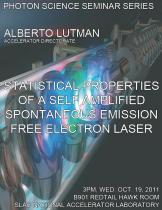Statistical properties of a Self Amplified Spontaneous Emission Free Electron Laser
Speaker: Alberto Lutman, Accelerator Directorate @ 3pm
Program Description
The process of amplification for Self Amplified Spontaneous Emission Free Electron Laser (SASE FEL) starts from the shot noise in the electron beam and therefore all the properties of the radiation pulse are of stochastic nature. We present an analysis of the statistical properties of the radiation from a SASE FEL operating both in the linear exponential growth regime and in the non-linear saturation regime.
Longitudinal and transverse coherence will be discussed and experimental data collected at the Linac Coherent Light Source (LCLS) will be shown. As an application, we present a novel method for measuring both the duration of femtosecond x-ray pulses and the spectrometer resolution by using the FEL spectral data. The method has been experimentally demonstrated at LCLS in the soft x-rays by measuring pulse duration down to 13 fs FWHM.
Seeing Electrons in Two-Dimensions: Optical Spectroscopy of Graphene
Speaker: Tony F. Heinz, Departments of Physics and Electrical Engineering (Columbia University) @ 4pm
Program Description
Optical spectroscopy provides an excellent means of understanding the distinctive properties of electrons in the two-dimensional system of graphene. Within the simplest picture, one has a (zero-gap) semiconductor with direct transitions between the well-known conical bands. This picture gives rise to a predicted frequency-dependent absorption of pa = 2.3%, where a is the fine-structure constant. We will demonstrate that this relation is indeed satisfied in an appropriate spectral range in the near infrared, but that at higher photon energies electron-hole interactions significantly modify this result through the formation of saddle-point excitons. Optical spectroscopy also permits a detailed analysis of how the linear bands of graphene, corresponding to massless Dirac Fermions, are modified to yield massive electrons through interlayer interactions in bilayer and few-layer graphene sheets. The observation of a tunable band gap in bilayer and trilayer graphene will also be discussed. We will present recent measurements in which the electron and phonon dynamics are investigated by ultrafast pump-probe spectroscopy.





